tow HONDA FIT 2017 3.G Owners Manual
[x] Cancel search | Manufacturer: HONDA, Model Year: 2017, Model line: FIT, Model: HONDA FIT 2017 3.GPages: 465, PDF Size: 26.52 MB
Page 3 of 465

Contents
This owner’s manual should be considered a permanent part of the
vehicle and should remain with the vehicle when it is sold.
This owner’s manual covers all models of your vehicle. You may find
descriptions of equipment and features that are not on your
particular model.
Images throughout this owner’s manual (including the front cover)
represent features and equipment that are available on some, but
not all, models. Your particular mo del may not have some of these
features.
This owner’s manual is for vehicles sold in the United States and
Canada.
The information and specifications in cluded in this publication were
in effect at the time of approval for printing. Honda Motor Co., Ltd.
reserves the right, however, to discontinue or change specifications
or design at any time without notice and without incurring any
obligation.2 Safe Driving P. 27
For Safe Driving P. 28 Seat Belts P. 32 Airbags P. 41
2Instrument Panel P. 69
Indicators P. 70 Gauges and Displays P. 85
2Controls P. 89
Clock P. 90 Locking and Unlocking the Doors P. 92
Opening and Closing the Windows P. 115
Operating the Switches Around the Steering Wheel P. 118
Interior Lights/Interior Convenience Items P. 147
2 Features P. 165
Audio System P. 166 Audio System Basic Operation P. 173
Customized Features P. 229 Bluetooth® HandsFreeLink ® P. 251
2 Driving P. 305
Before Driving P. 306 Towing a Trailer P. 311
Multi-View Rear Camera P. 356
2Maintenance P. 363
Before Performing Maintenance P. 364 Maintenance MinderTM P. 367
Checking and Maintaining Wiper Blades P. 390
Heating and Cooling System
*/Climate Control System* Maintenance P. 407
2 Handling the Unexpected P. 413
Tools P. 414 If a Tire Goes Flat P. 415
Overheating P. 427 Indicator, Coming On/Blinking P. 429 Fuses P. 433
2 Information P. 441
Specifications P. 442 Identification Numbers P. 444
Emissions Testing P. 447 Warranty Coverages P. 449
17 FIT -31T5A6200.book 2 ページ 2016年5月27日 金曜日 午後6時33分
Page 4 of 465

Contents
Child Safety P. 54Exhaust Gas Hazard P. 66Safety Labels P. 67
Opening and Closing the Tailgate P. 109 Security System P. 112
Opening and Closing the Moonroof* P. 117
Adjusting the Mirrors P. 133 Adjusting the Seats P. 135
Heating and Cooling System
* P. 157 Climate Control System* P. 160
Audio Error Messages P. 222General Information on the Audio System P. 226
When Driving P. 315 Braking P. 351Parking Your Vehicle P. 355
Refueling P. 358 Fuel Economy and CO
2 Emissions P. 361 Accessories and Modifications P. 362
Maintenance Under the Hood P. 371 Replacing Light Bulbs P. 383
Checking and Maintaining Tires P. 394 Battery P. 403 Remote Transmitter Care P. 405
Cleaning P. 408
Engine Does Not Start P. 421Jump Starting P. 424 Shift Lever Does Not Move P. 426
Emergency Towing P. 438 When You Cannot Open the Tailgate P. 439
Devices that Emit Radio Waves P. 445 Reporting Safety Defects P. 446
Authorized Manuals P. 451 Customer Service Information P. 452
Quick Reference GuideP. 4
Safe DrivingP. 27
Instrument PanelP. 69
ControlsP. 89
FeaturesP. 165
DrivingP. 305
MaintenanceP. 363
Handling the UnexpectedP. 413
InformationP. 441
IndexP. 455
17 FIT -31T5A6200.book 3 ページ 2016年5月27日 金曜日 午後6時33分
Page 14 of 465

13
Quick Reference Guide
Engine START/STOP
Button
* (P119)
Press the button to change the vehicle’s
power mode.
Turn Signals (P123)
Lights (P123)
Turn Signal Control Lever
Right
Left
Light Control Switches
Low Beam High Beam
Flashing
Wipers and Washers
(P128)
Wiper/Washer Control Lever
MIST
OFF
INT: Low speed with intermittent
LO : Low speed wipe
HI: High speed wipe Pull toward
you to spray
washer fluid.
*
Not available on all models
17 FIT -31T5A6200.book 13 ページ 2016年5月27日 金曜日 午後6時33分
Page 15 of 465

14
Quick Reference Guide
Steering Wheel (P132)
● To adjust, pull the adjustment lever
towards you, adjust to the desired
position, then lock the lever back in place.
To adjust
To lock
Unlocking the Front
Doors from the Inside
(P102)
● Pull either front door inner handle to
unlock and open it in one motion.
● Unlocking and opening the driver’s door
from the inner handle unlocks all the
other doors.
Tailgate (P109)
● With all the doors unlocked, pull the
tailgate outer handle, and lift up to open it.
● With all the doors unlocked, push the
tailgate release button on the tailgate to
open it.
● Press the tailgate release button to
unlock and open the tailgate when you
carry the smart entry remote.
Models without smart entry system
Models with smart entry system
17 FIT -31T5A6200.book 14 ページ 2016年5月27日 金曜日 午後6時33分
Page 24 of 465
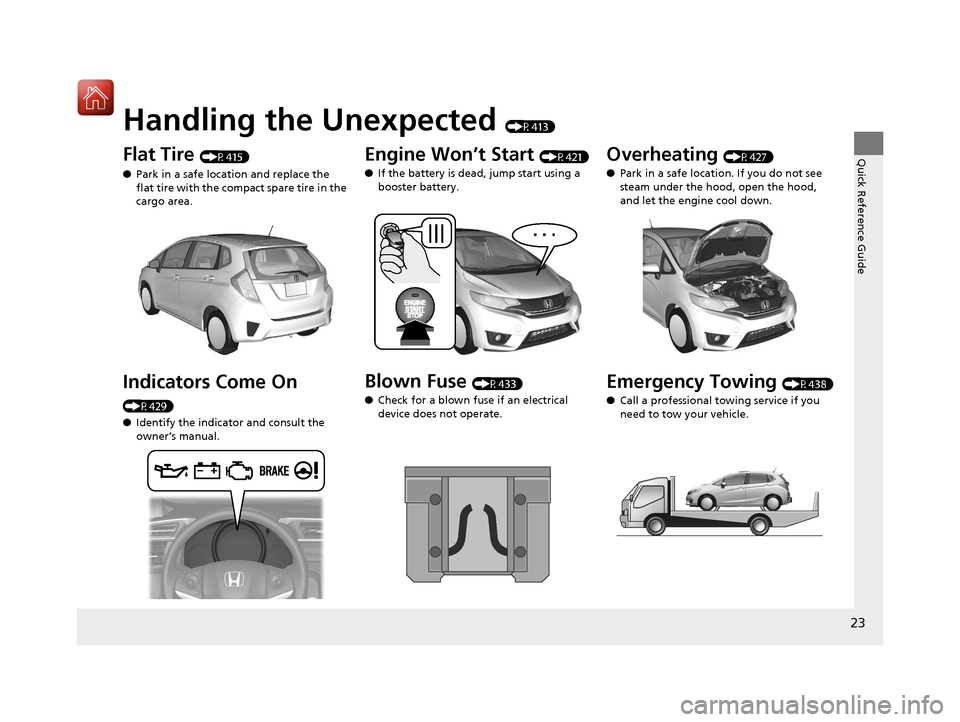
Quick Reference Guide
23
Handling the Unexpected (P413)
Flat Tire (P415)
● Park in a safe location and replace the
flat tire with the comp act spare tire in the
cargo area.
Indicators Come On
(P429)
● Identify the indica tor and consult the
owner’s manual.
Engine Won’t Start (P421)
● If the battery is dead, jump start using a
booster battery.
Blown Fuse (P433)
● Check for a blown fuse if an electrical
device does not operate.
Overheating (P427)
● Park in a safe location. If you do not see
steam under the hood, open the hood,
and let the engine cool down.
Emergency Towing (P438)
● Call a professional towing service if you
need to tow your vehicle.
17 FIT -31T5A6200.book 23 ページ 2016年5月27日 金曜日 午後6時33分
Page 47 of 465

46
uuAirbags uFront Airbags (SRS)
Safe Driving
■When front airbags should not deploy
Minor frontal crashes: Front airbags were designed to supplement seat belts and
help save lives, not to prevent minor scrapes, or even broken bones that might occur
during a less than moderate-to-severe frontal crash.
Side impacts: Front airbags can provide protection when a sudden deceleration
causes a driver or front passenger to move towards the front of the vehicle. Side
airbags and side curtain airb ags have been specifically designed to help reduce the
severity of injuries that can occur during a moderate-to-severe side impact which
can cause the driver or passenger to move towards the side of the vehicle.
Rear impacts: Head restraints and seat belts are your best protection during a rear
impact. Front airbags cannot provide any significant protection and are not designed
to deploy in such collisions.
Rollovers: Seat belts and, in vehicles equipped with a rollover sensor, side airbags
and side curtain airbags offer the best prot ection in a rollover. Because front airbags
could provide little if any protection, they are not designed to deploy during a
rollover.
■When front airbags deploy with little or no visible damage
Because the airbag system senses sudden deceleration, a strong impact to the
vehicle framework or suspension might caus e one or more of the airbags to deploy.
Examples include running into a curb, the edge of a hole, or other low fixed object
that causes a sudden deceleration in th e vehicle chassis. Since the impact is
underneath the vehicle, damage may not be readily apparent.
■When front airbags may not deploy, even though exterior damage
appears severe
Since crushable body parts absorb crash energy during an impact, the amount of
visible damage does not always indicate proper airbag operation. In fact, some
collisions can result in severe damage but no airbag deployment because the airbags
would not have been needed or would not have provided protection even if they
had deployed.
17 FIT -31T5A6200.book 46 ページ 2016年5月27日 金曜日 午後6時33分
Page 50 of 465
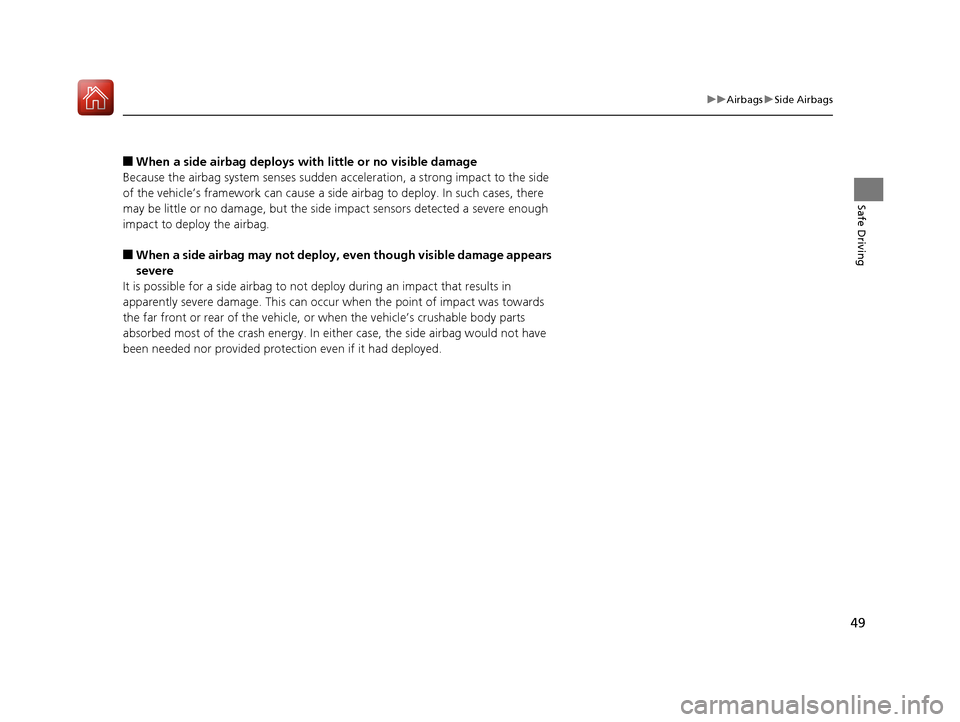
49
uuAirbags uSide Airbags
Safe Driving
■When a side airbag deploys with little or no visible damage
Because the airbag system senses sudden acceleration, a strong impact to the side
of the vehicle’s framework can cause a side airbag to deploy. In such cases, there
may be little or no damage, but the side impact sensors detected a severe enough
impact to deploy the airbag.
■When a side airbag may not deploy, even though visible damage appears
severe
It is possible for a side airbag to not deploy during an impact that results in
apparently severe damage. This can occu r when the point of impact was towards
the far front or rear of the vehicle, or when the vehicle’s crushable body parts
absorbed most of the crash energy. In either case, the side airbag would not have
been needed nor provided protec tion even if it had deployed.
17 FIT -31T5A6200.book 49 ページ 2016年5月27日 金曜日 午後6時33分
Page 129 of 465
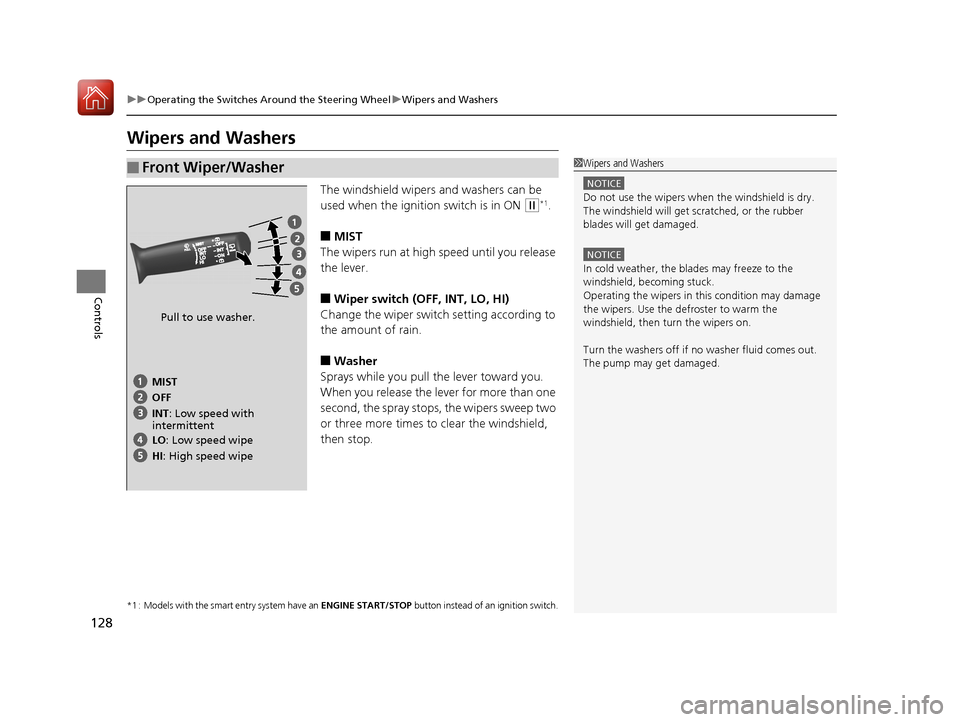
128
uuOperating the Switches Around the Steering Wheel uWipers and Washers
Controls
Wipers and Washers
The windshield wipers and washers can be
used when the ignition switch is in ON
(w*1.
■MIST
The wipers run at high speed until you release
the lever.
■Wiper switch (OFF, INT, LO, HI)
Change the wiper switch setting according to
the amount of rain.
■Washer
Sprays while you pull the lever toward you.
When you release the lever for more than one
second, the spray stops, the wipers sweep two
or three more times to clear the windshield,
then stop.
*1 : Models with the smart entry system have an ENGINE START/STOP button instead of an ignition switch.
■Front Wiper/Washer1Wipers and Washers
NOTICE
Do not use the wipers when the windshield is dry.
The windshield will get sc ratched, or the rubber
blades will get damaged.
NOTICE
In cold weather, the blades may freeze to the
windshield, becoming stuck.
Operating the wipers in th is condition may damage
the wipers. Use the defroster to warm the
windshield, then turn the wipers on.
Turn the washers off if no washer fluid comes out.
The pump may get damaged.
Pull to use washer.
MIST
INT: Low speed with
intermittent OFF
LO : Low speed wipe
HI: High speed wipe
17 FIT -31T5A6200.book 128 ページ 2016年5月27日 金曜日 午後6時33分
Page 306 of 465
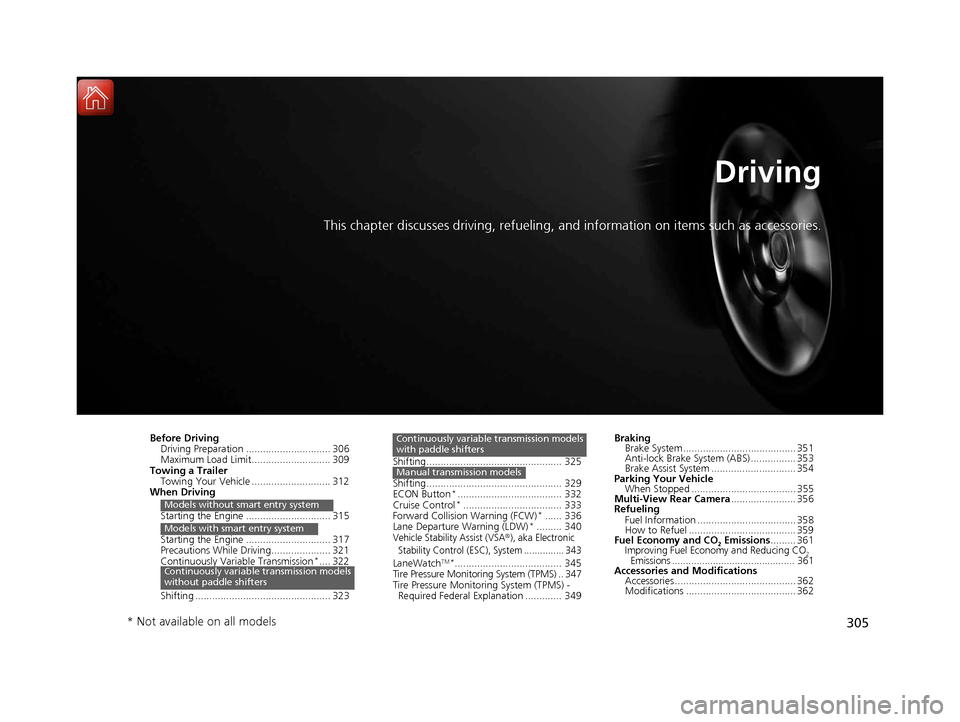
305
Driving
This chapter discusses driving, refueling, and information on items such as accessories.
Before Driving
Driving Preparation .............................. 306
Maximum Load Limit............................ 309
Towing a Trailer Towing Your Vehicle ............................ 312
When Driving
Starting the Engine .............................. 315
Starting the Engine .............................. 317
Precautions While Driving..................... 321
Continuously Variable Transmission
*.... 322
Shifting ................................................ 323
Models without smart entry system
Models with smart entry system
Continuously variable transmission models
without paddle shifters
Shifting................................................ 325
Shifting................................................ 329
ECON Button
*..................................... 332
Cruise Control*................................... 333
Forward Collision Warning (FCW)*...... 336
Lane Departure Warning (LDW)*......... 340Vehicle Stability Assist (VSA®), aka Electronic
Stability Control (ESC), System ............... 343
LaneWatchTM*...................................... 345
Tire Pressure Monitoring System (TPMS) .. 347
Tire Pressure Monitoring System (TPMS) - Required Federal Explanation ............. 349
Continuously variable transmission models
with paddle shifters
Manual transmission models
Braking Brake System ........................................ 351
Anti-lock Brake System (ABS) ................ 353
Brake Assist System .............................. 354
Parking Your Vehicle When Stopped ..................................... 355
Multi-View Rear Camera ....................... 356
Refueling
Fuel Information ................................... 358
How to Refuel ...................................... 359
Fuel Economy and CO
2 Emissions ......... 361
Improving Fuel Economy and Reducing CO2
Emissions ............................................. 361
Accessories and Modifications Accessories ........................................... 362
Modifications ....................................... 362
* Not available on all models
17 FIT -31T5A6200.book 305 ページ 2016年5月27日 金曜日 午後6時33分
Page 310 of 465
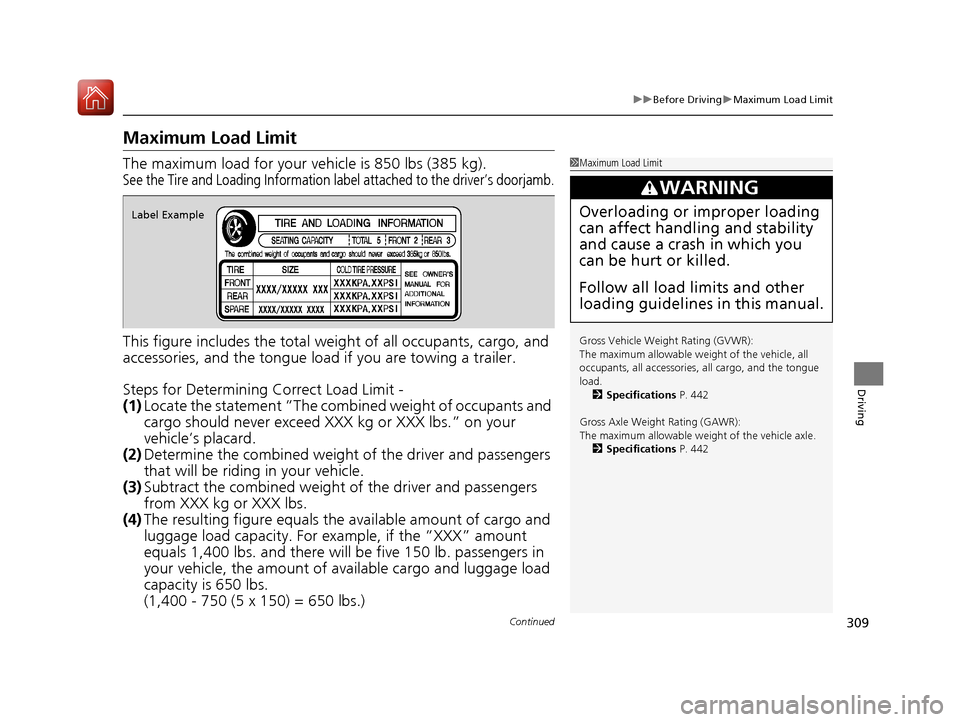
309
uuBefore Driving uMaximum Load Limit
Continued
Driving
Maximum Load Limit
The maximum load for your ve hicle is 850 lbs (385 kg).
See the Tire and Loading Information label attached to the driver’s doorjamb.
This figure includes the total weig ht of all occupants, cargo, and
accessories, and the tongue load if you are towing a trailer.
Steps for Determining Correct Load Limit -
(1) Locate the statement “The comb ined weight of occupants and
cargo should never exceed XXX kg or XXX lbs.” on your
vehicle’s placard.
(2) Determine the combined weight of the driver and passengers
that will be riding in your vehicle.
(3) Subtract the combined weight of the driver and passengers
from XXX kg or XXX lbs.
(4) The resulting figure equals the available amount of cargo and
luggage load capacity. For example, if the “XXX” amount
equals 1,400 lbs. and there will be five 150 lb. passengers in
your vehicle, the am ount of available cargo and luggage load
capacity is 650 lbs.
(1,400 - 750 (5 x 150) = 650 lbs.)
1 Maximum Load Limit
Gross Vehicle Weight Rating (GVWR):
The maximum allowable weight of the vehicle, all
occupants, all a ccessories, all cargo, and the tongue
load. 2 Specifications P. 442
Gross Axle Weight Rating (GAWR):
The maximum allowable weight of the vehicle axle. 2 Specifications P. 442
3WARNING
Overloading or improper loading
can affect handling and stability
and cause a crash in which you
can be hurt or killed.
Follow all load limits and other
loading guidelines in this manual.Label Example
17 FIT -31T5A6200.book 309 ページ 2016年5月27日 金曜日 午後6時33分